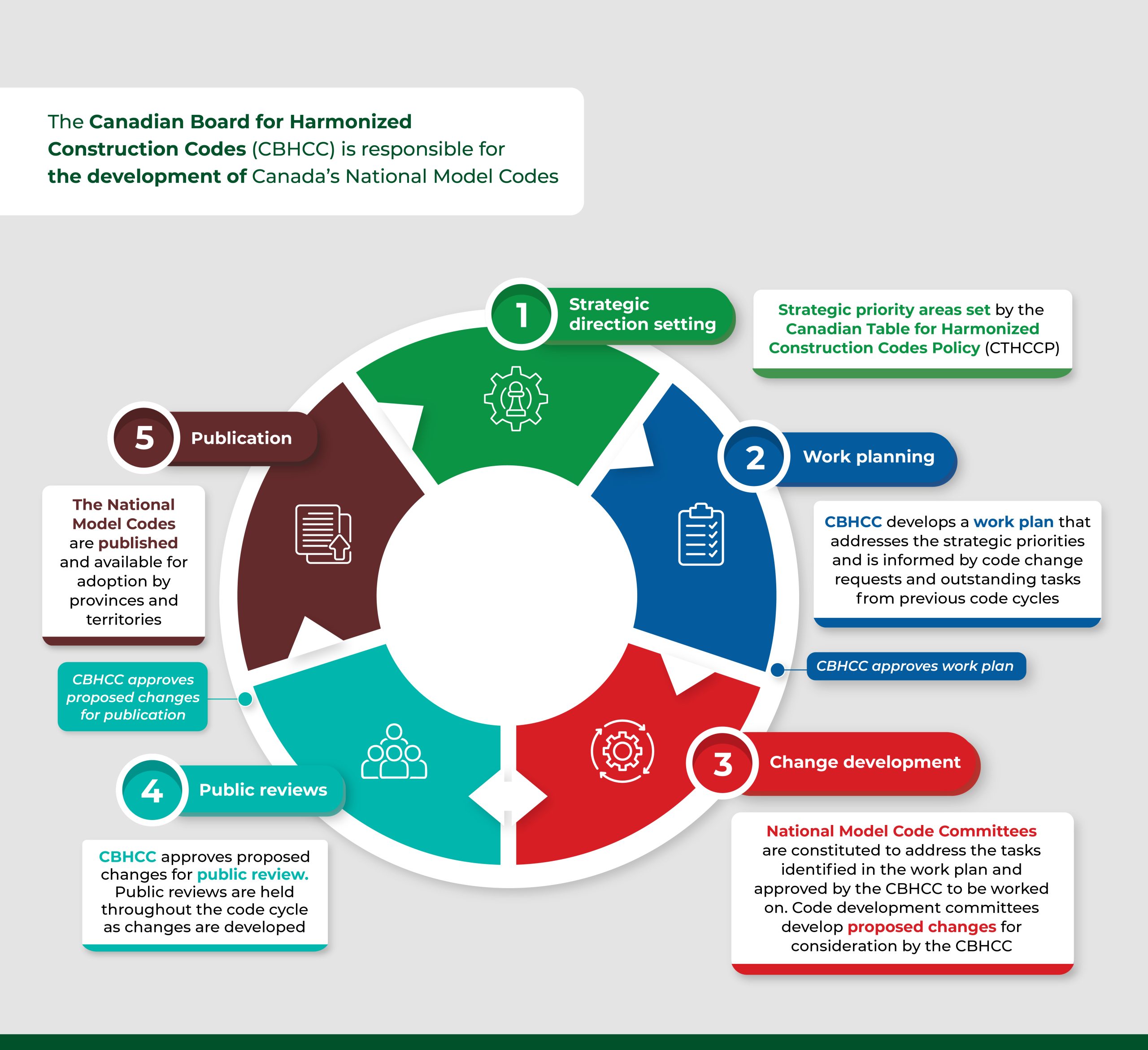The National Model Codes are continuously evolving to accommodate new technologies, materials, construction practices, research, and the changing needs of Canadian society.
The development of Codes content is a consensus-based process that relies on volunteers who participate on code development committees, and input from the construction sector, other interested organizations and the public.
The process for developing and maintaining the Codes
The code development process is comprised of five major steps. Refer to the infographic below to learn more.
Development process of Canada’s National Model Codes

Long description of the infographic of the development process of Canada’s National Model Codes
This infographic illustrates the five-step process used by the Canadian Board for Harmonized Construction Codes (CBHCC) to develop Canada’s National Model Codes. The steps are arranged in a circular flowchart, with each step represented by a numbered segment of the circle. Each step is color-coded for differentiation.
Step 1: Strategic direction setting
- The first segment of the circle is green and positioned at the top.
- Inside this segment, there is a white icon depicting a gear with a light bulb inside it.
- A callout box to the right states:
- “Strategic priority areas are set by the Canadian Table for Harmonized Construction Codes Policy (CTHCCP).”
Step 2: Work planning
- The second segment, moving clockwise, is blue and located to the right of Step 1.
- This segment contains a white icon of a clipboard with a checklist.
- A blue callout box states:
- “CBHCC develops a work plan that addresses the strategic priorities and is informed by code change requests and outstanding tasks from previous code cycles.”
- Another blue callout at the edge of Step 2, where it transitions into Step 3, states:
- “CBHCC approves work plan.”
Step 3: Change development
- The third segment is red and located at the bottom right.
- A white icon of interlocking gears is placed inside this segment.
- A white callout box with red headings states:
- “National Model Code Committees are constituted to address the tasks identified in the work plan and approved by the CBHCC to be worked on. Code development committees develop proposed changes for consideration by the CBHCC.”
- At the transition between Step 3 and Step 4, a two-way arrow is present, indicating an iterative process between these two steps.
Step 4: Public Reviews
- The fourth segment is teal and positioned at the bottom left.
- This segment contains a white icon of a group of people.
- A white callout box with teal headings states:
- “CBHCC approves proposed changes for public review. Public reviews are held throughout the code cycle as changes are developed.”
- Where Step 4 transitions into Step 5, a teal callout states:
- “CBHCC approves proposed changes for publication.”
Step 5: Publication
- The final segment is brown and positioned at the top left.
- A white icon of stacked documents is displayed inside this segment.
- A white callout box with brown headings states:
- “The National Model Codes are published and available for adoption by provinces and territories.”
1. Strategic direction setting
The Canadian Table for Harmonized Construction Codes Policy (CTHCCP) establishes strategic priority areas for the Codes. These areas become the focus of code development activities for the code cycle.
The priorities are selected by representatives of the federal, provincial, and territorial jurisdictions who serve on the CTHCCP. Priorities are selected through a consensus-based process with input from the Canadian Board for Harmonized Construction Codes (CBHCC), which in turn receives input from the Advisory Council for Harmonized Construction Codes.
You can learn more about the CTHCCP’s role in the code development process here.
2. Work planning
After the strategic priority areas have been established for the code cycle, the CBHCC develops a detailed work plan that responds to the strategic priority areas and is informed by input collected from code change requests, outstanding tasks carried forward from previous code cycles, and maintenance and other work necessary to maintain the functionality of the Codes. The work plan is reviewed periodically and may be updated based on available capacity, and in response to new and urgent priorities.
3. Change development
National Model Code Committees are constituted to address the tasks identified in the work plan and approved by the CBHCC to be worked on. Code development committees develop proposed changes for consideration by the CBHCC. In certain cases, in order to augment capacity, federal, provincial and/or territorial officials may undertake the development of changes for consideration by committees.
4. Public reviews and code change approval
All proposed changes recommended by code development committees and approved to proceed to public review by the CBHCC are made available for a public review period in both official languages. Public reviews are an opportunity for code users, the codes community, and the public to review proposed changes and provide feedback.
You can learn more about public reviews here.
Following the public review period, all public comments are considered by the responsible code development committees. If deemed ready for approval, the committees will recommend the proposed changes to the CBHCC, with advice on whether to undertake another round of public review. The CBHCC may choose to:
- forward the proposed change to public review with or without modifications;
- defer a proposed code change pending further development; or
- withdraw a proposed change from further development.
The CBHCC’s decision is made available at public CBHCC meetings.
5. Publication
Once approved by the CBHCC, the changes are published by the National Research Council of Canada (NRC) in the next revision or edition of the Codes.
New editions of the National Model Codes and related guides, incorporating changes developed and approved over the code cycle, are published approximately every five years.
The National Model Codes are available for free in electronic format from NRC Publications Archive, and for purchase in printed format through the NRC’s Virtual Store.
